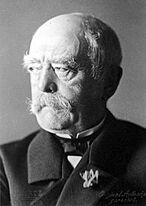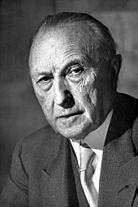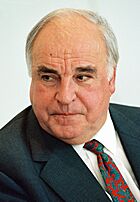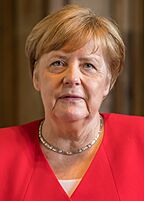List of chancellors of Germany facts for kids
- Top left: Otto von Bismarck was the first chancellor of Germany with the creation of the North German Confederation and later the German Empire.
- Top right: Konrad Adenauer was the first chancellor of the Federal Republic of Germany.
- Bottom left: Helmut Kohl was chancellor during the period of German reunification in 1990.
- Bottom right: Angela Merkel was the first female chancellor of Germany.
The chancellor of Germany is the political leader of Germany and the head of the federal government. The office holder is responsible for selecting all other members of the government and chairing cabinet meetings.
The office was created in the North German Confederation in 1867, when Otto von Bismarck became the first chancellor. With the unification of Germany and establishment of the German Empire in 1871, the Confederation evolved into a German nation-state and its leader became known as the chancellor of Germany. Originally, the chancellor was only responsible to the emperor. This changed with the constitutional reform in 1918, when the Parliament was given the right to dismiss the chancellor. Under the 1919 Weimar Constitution the chancellors were appointed by the directly elected president, but were responsible to Parliament.
The constitution was set aside during the 1933–1945 Nazi regime. During the Allied occupation, no independent German government and no chancellor existed; and the office was not reconstituted in East Germany, thus the head of government of East Germany was chairman of the Council of Ministers. The 1949 Basic Law made the chancellor the most important office in West Germany, while diminishing the role of the president.
Contents
North German Confederation (1867–1871)
The North German Confederation came into existence after the German Confederation was dissolved following the Prussian victory in the Austro-Prussian War of 1866. The chancellor was appointed by the Bundespräsidium, a position that was held constitutionally by the Prussian king.
| Portrait | Name (born–died) |
Term of office | Political party | |||
|---|---|---|---|---|---|---|
| Took office | Left office | Time in office | ||||
 |
Otto von Bismarck (1815–1898) |
1 July 1867 |
21 March 1871 |
3 years, 263 days | Non-partisan | |
German Reich (1871–1945)
German Empire (1871–1918)
The German Empire was born out of the North German Confederation as result of the Franco-Prussian War (1870/71). The Präsidium (the Prussian king), which now had also the title Emperor, named the chancellor.
Political parties: None Centre
| No. | Portrait | Name (born–died) |
Term of office | Political party | Cabinet | |||
|---|---|---|---|---|---|---|---|---|
| Took office | Left office | Time in office | ||||||
| 1 |  |
Otto von Bismarck (1815–1898) |
21 March 1871 |
20 March 1890 |
18 years, 364 days | Non-partisan | Bismarck | |
| 2 |  |
Leo von Caprivi (1831–1899) |
20 March 1890 |
26 October 1894 |
4 years, 220 days | Non-partisan | Caprivi | |
| 3 |  |
Chlodwig zu Hohenlohe-Schillingsfürst (1819–1901) |
29 October 1894 |
17 October 1900 |
5 years, 353 days | Non-partisan | Hohenlohe-Schillingsfürst | |
| 4 |  |
Bernhard von Bülow (1849–1929) |
17 October 1900 |
14 July 1909 |
8 years, 270 days | Non-partisan | Bülow | |
| 5 |  |
Theobald von Bethmann Hollweg (1856–1921) |
14 July 1909 |
13 July 1917 |
7 years, 364 days | Non-partisan | Bethmann Hollweg | |
| 6 |  |
Georg Michaelis (1857–1936) |
14 July 1917 |
1 November 1917 |
110 days | Non-partisan | Michaelis | |
| 7 |  |
Georg von Hertling (1843–1919) |
1 November 1917 |
30 September 1918 |
333 days | Centre Party | Hertling | |
| 8 |  |
Max von Baden (1867–1929) |
3 October 1918 |
9 November 1918 |
37 days | Non-partisan | Baden | |
Weimar Republic (1918–1933)
On 9 November 1918, Chancellor Max von Baden handed over his office to Friedrich Ebert. Ebert continued to serve as head of government during the three months between the end of the German Empire in November 1918 and the first gathering of the National Assembly in February 1919 as Chairman of the Council of the People's Deputies, until 29 December 1918 together with USPD Leader Hugo Haase.
The Weimar Constitution of 1919 set the framework for the Weimar Republic. The chancellors were officially installed by the president; in some cases the chancellor did not have a majority in parliament.
Political parties: SPD Centre DVP Nazi None
| No. | Portrait | Name (born–died) |
Term of office | Political party | Cabinet | Reichstag | |||
|---|---|---|---|---|---|---|---|---|---|
| Took office | Left office | Time in office | |||||||
| 9 |  |
Friedrich Ebert (1871–1925) |
9 November 1918 |
13 February 1919 |
96 days | Social Democratic Party (SPD) |
Council of the People's Deputies SPD–USPD (as of 29 December 1918 SPD alone) |
– | |
| 10 |  |
Philipp Scheidemann (1865–1939) |
13 February 1919 |
20 June 1919 |
127 days | Social Democratic Party (SPD) |
Scheidemann SPD–DDP–Z (Weimar Coalition) |
Nat.Ass. (Jan.1919) |
|
| 11 |  |
Gustav Bauer (1870–1944) |
21 June 1919 |
26 March 1920 |
273 days | Social Democratic Party (SPD) |
Bauer SPD–DDP–Z (Weimar Coalition) |
||
| 12 |  |
Hermann Müller (1876–1931) |
27 March 1920 |
21 June 1920 |
86 days | Social Democratic Party (SPD) |
Müller I SPD–DDP–Z (Weimar Coalition) |
Nat.Ass. (Jan.1919) |
|
| 13 |  |
Constantin Fehrenbach (1852–1926) |
25 June 1920 |
10 May 1921 |
319 days | Centre Party | Fehrenbach Z–DDP–DVP |
1 (Jun.1920) |
|
| 14 |  |
Joseph Wirth (1879–1956) |
10 May 1921 |
22 November 1922 |
1 year, 196 days | Centre Party | Wirth I Z–SPD–DDP (Weimar Coalition) |
||
| Wirth II Z–SPD–DDP (Weimar Coalition) |
|||||||||
| 15 |  |
Wilhelm Cuno (1876–1933) |
22 November 1922 |
12 August 1923 |
263 days | Non-partisan | Cuno Ind.–DVP–DDP–Z–BVP |
||
| 16 |  |
Gustav Stresemann (1878–1929) |
13 August 1923 |
30 November 1923 |
109 days | German People's Party | Stresemann I DVP–SPD–Z–DDP |
||
| Stresemann II DVP–SPD–Z–DDP |
|||||||||
| 17 |  |
Wilhelm Marx (1863–1946) |
30 November 1923 |
15 January 1925 |
1 year, 46 days | Centre Party | Marx I Z–DVP–BVP–DDP |
||
| Marx II Z–DVP–DDP |
2 (May 1924) |
||||||||
| 18 |  |
Hans Luther (1879–1962) |
15 January 1925 |
12 May 1926 |
1 year, 117 days | Non-partisan | Luther I DVP–DNVP–Z–DDP–BVP |
3 (Dec.1924) |
|
| Luther II DVP–Z–DDP–BVP |
|||||||||
| 19 |  |
Wilhelm Marx (1863–1946) |
17 May 1926 |
28 June 1928 |
2 years, 42 days | Centre Party | Marx III Z–DVP–DDP–BVP |
||
| Marx IV Z–DNVP–DVP–BVP |
|||||||||
| 20 |  |
Hermann Müller (1876–1931) |
28 June 1928 |
27 March 1930 |
1 year, 272 days | Social Democratic Party (SPD) |
Müller II SPD–DVP–DDP–Z–BVP |
4 (May 1928) |
|
| 21 |  |
Heinrich Brüning (1885–1970) |
30 March 1930 |
30 May 1932 |
2 years, 61 days | Centre Party | Brüning I Z–DDP–DVP–WF–BVP–KVP |
5 (Sep.1930) |
|
| Brüning II Z–DSP–BVP–KVP–CLV |
|||||||||
| 22 |  |
Franz von Papen (1879–1969) |
1 June 1932 |
3 December 1932 |
185 days | Non-partisan | Papen Ind.–DNVP |
6 (Jul.1932) |
|
| 23 |  |
Kurt von Schleicher (1882–1934) |
3 December 1932 |
30 January 1933 |
58 days | Non-partisan | Schleicher Ind.–DNVP |
7 (Nov.1932) |
|
| 24 |  |
Adolf Hitler (1889–1945) |
30 January 1933 |
24 March 1933 |
53 days | National Socialist German Workers' Party |
Hitler NSDAP – DNVP |
8 (Mar. 1933) | |
Nazi Germany (1933–1945)
Soon after Adolf Hitler was appointed as chancellor in 1933, the German Reichstag (parliament) passed the so-called Enabling Act (German: Ermächtigungsgesetz), officially titled "Law for Removing the Distress of People and Reich" (German: Gesetz zur Behebung der Not von Volk und Reich), which effectively gave the chancellor the power of a dictator. This event marked the end of the Weimar Republic and the beginning of Nazi Germany. Hitler thereupon destroyed all democratic systems and consolidated all power to himself. After the death of president Paul von Hindenburg in 1934, Hitler merged the offices of chancellor and president in his own person and called himself Führer und Reichskanzler.
Political parties: Nazi
| No. | Portrait | Name (born–died) |
Term of office | Political party | Cabinet | Reichstag | |||
|---|---|---|---|---|---|---|---|---|---|
| Took office | Left office | Time in office | |||||||
| 25 |  |
Adolf Hitler (1889–1945) |
24 March 1933 |
30 April 1945 |
12 years, 37 days | National Socialist German Workers' Party |
Hitler NSDAP |
9 (Nov. 1933) | |
| 10 (Mar. 1936) | |||||||||
| 11 (Apr. 1938) | |||||||||
| 26 |  |
Joseph Goebbels (1897–1945) |
30 April 1945 |
1 May 1945 |
1 day | National Socialist German Workers' Party |
Goebbels NSDAP |
— | |
| 27 |  |
Lutz Graf Schwerin von Krosigk (1887–1977) |
2 May 1945 |
23 May 1945 |
21 days | National Socialist German Workers' Party |
Schwerin von Krosigk NSDAP |
— | |
Federal Republic of Germany (1949–present)
In 1949, two separate German states were established: the Federal Republic of Germany (known as West Germany) and the German Democratic Republic (known as East Germany). The list below gives the chancellors of West Germany; the government of East Germany was headed by the chairman of the Council of Ministers. In 1990, East Germany was dissolved as it merged with West Germany; Germany was reunified. It retained the name of the Federal Republic of Germany.
Political parties: CDU (4) SPD (4) Independent (1) Denotes acting (i.e. ad interim)
| No. | Portrait | Name (born–died) |
Term of office | Political party | Cabinet | Bundestag | |||
|---|---|---|---|---|---|---|---|---|---|
| Took office | Left office | Time in office | |||||||
| 1 |  |
Konrad Adenauer (1876–1967) |
15 September 1949 |
15 October 1963 |
14 years, 30 days | Christian Democratic Union (CDU) |
Adenauer I CDU/CSU–FDP–DP |
1 (1949) | |
| Adenauer II CDU/CSU–FDP/FVP–DP–GB/BHE |
2 (1953) | ||||||||
| Adenauer III CDU/CSU–DP |
3 (1957) | ||||||||
| Adenauer IV CDU/CSU–FDP |
4 (1961) | ||||||||
| 2 |  |
Ludwig Erhard (1897–1977) |
15 October 1963 |
30 November 1966 |
3 years, 45 days | Independent | Erhard I CDU/CSU–FDP |
||
| Erhard II CDU/CSU–FDP |
5 (1965) | ||||||||
| 3 |  |
Kurt Georg Kiesinger (1904–1988) |
30 November 1966 |
21 October 1969 |
2 years, 324 days | Christian Democratic Union (CDU) |
Kiesinger CDU/CSU–SPD |
||
| 4 |  |
Willy Brandt (1913–1992) |
21 October 1969 |
7 May 1974 |
4 years, 197 days | Social Democratic Party (SPD) |
Brandt I SPD–FDP |
6 (1969) | |
| Brandt II SPD–FDP |
7 (1972) | ||||||||
| – |  |
Walter Scheel (1919–2016) Acting |
7 May 1974 |
16 May 1974 |
9 days | Free Democratic Party (FDP) |
Brandt II (acting) |
||
| 5 |  |
Helmut Schmidt (1918–2015) |
16 May 1974 |
1 October 1982 |
8 years, 138 days | Social Democratic Party (SPD) |
Schmidt I SPD–FDP |
||
| Schmidt II SPD–FDP |
8 (1976) | ||||||||
| Schmidt III SPD–FDP |
9 (1980) | ||||||||
| 6 |  |
Helmut Kohl (1930–2017) |
1 October 1982 |
27 October 1998 |
16 years, 26 days | Christian Democratic Union (CDU) |
Kohl I CDU/CSU–FDP |
||
| Kohl II CDU/CSU–FDP |
10 (1983) | ||||||||
| Kohl III CDU/CSU–FDP |
11 (1987) | ||||||||
| Kohl IV CDU/CSU–FDP |
12 (1990) | ||||||||
| Kohl V CDU/CSU–FDP |
13 (1994) | ||||||||
| 7 |  |
Gerhard Schröder (born 1944) |
27 October 1998 |
22 November 2005 |
7 years, 26 days | Social Democratic Party (SPD) |
Schröder I SPD–Green |
14 (1998) | |
| Schröder II SPD–Green |
15 (2002) | ||||||||
| 8 |  |
Angela Merkel (born 1954) |
22 November 2005 |
8 December 2021 |
16 years, 16 days | Christian Democratic Union (CDU) |
Merkel I CDU/CSU–SPD |
16 (2005) | |
| Merkel II CDU/CSU–FDP |
17 (2009) | ||||||||
| Merkel III CDU/CSU–SPD |
18 (2013) | ||||||||
| Merkel IV CDU/CSU–SPD |
19 (2017) | ||||||||
| 9 |  |
Olaf Scholz (born 1958) |
8 December 2021 |
Incumbent | 2 years, 143 days | Social Democratic Party (SPD) |
Scholz SPD–Green–FDP |
20 (2021) | |
Timeline

See also
- Leadership of East Germany
- List of chancellors of Germany by time in office
- List of German monarchs
- List of German presidents
- Minister-Presidents of the French "Saar protectorate"
- Religious affiliations of chancellors of Germany
- List of vice chancellors of Germany





